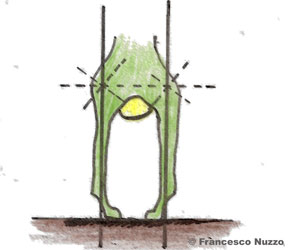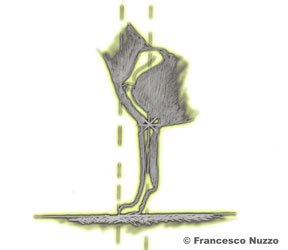- WELCOME
- HOME
- ABOUT US
- CHAMPIONS
-
VERY IMPORTANT DOG
- Ch. South Fork's Jelly Bean
- Ch. South Fork's The Beat Goes On
- Ch. Yo Te Quiero Di Rio Galeria
- Ch. South Fork' Jazz It Up
- Ch. Tocai Di Rio Galeria
- Ch. South Fork's Contradiction
- Ch. South Fork's Music Man
- Ch. El Nino Di Rio Galeria
- Ch. Xsaraja Di Rio Galeria
- Ch. De Gozette Lotus
- Ch. Eldorado Di Rio Galeria
- Ch. Jaqueline Di Rio Galeria
- Ch. Dacarella's Hellf Angel
- SHOW RESULTS
- PUPPIES
- INFO CHIHUAHUA
- CONTACTS
- TOOLS
Dog Expertise
By Paolo Tartaro and Francesco di Paola Nuzzo
- Source: Magazine All About Chihuahua n° 8
| In the eighth AAC issue, dedicated to the study of the dog morphology, we will only look at the forelegs or chest limb. If in dog science we always find the description of the front leg along with the chest (shoulder), which are understandably not separable, in this eighth issue we restrict ourselves to talking only of the front legs as the 'argument "shoulder" has already been addressed in a previous issue of AAC (No. 3 January 2011) The dog, as we all know, is a quadruped since there are two forelegs and two hindlegs (also called abdominal or pelvic), these four pillars have the dual function of supporting body weight and to allow locomotion. The legs actors of both static and kinematics have to be as correct as possible, both in terms of upright conformation that, in order to perform their function optimally support, absorb the return pressure from the ground, and all the twists and flexion-extension that the Chihuahua is subjected when in motion. All this thanks to the perfect mechanism formed by the bones rays, the angles of the joints, muscles, ligaments and tendons and so forth. |
| FORELIMB The fore legs are two, and their primary tasks is to support, as they bear most of the dog's body weight, were the hind legs instead performs mostly a propulsive role. The anatomical regions that make up the front limbs are the shoulder (or chest-strap), arm, elbow, forearm, wrist, metacarpophalangeal, and finally the foot. The bones of the front upright form three angles: the angle of the scapula, humerus, the humeral-radial angle and the metacarpophalangeal angle. ARM Its anatomical basis is formed by a single bone, the humerus, and two groups of muscles attached to it. At the top it articulates with the scapula, with which it forms the shoulder joint, while inferiorly it articulates with the ulna and radius, forming with it the last humero-radio-ulnar joint (elbow). The humerus has a slanting craniocaudal direction from top to bottom, in opposite direction to that of the scapula to that purpose, it requires a proper skeletal and muscle length to allow for greater extension in the strtch of the limb, it goes without saying that a too short humerus generate a short step, in addition to the fault of a too wide angle. It is also true that to get a right forward projection, the shoulder should be suitably long and correctly angled (see AAC n° 3 January 2011). This slant in the humerus of the Chihuahua, called in dogscience inclination is between 45 and 55 degrees to the horizontal so that angle of shoulder joint is more or less than 110 degrees. |
|
| To measure the angle of the humerus an imaginary perpendicular line should be drawn starting from the upper tip of the scapula, the first endpoint of the segment up to the elbow, the second endpoint of the segment. If the two enpoint, in the Chihuahua, are aligned, we can generally say that the humerus is rightly inclined. This assessment is very easy to do on a smoothcoat subject, and a little more difficult in loncoat subject because of the presence of the longer coat, an element of distraction in this case. Important is to remember that the arm's direction is assessed relatively to the median plane of the dog, having to be almost parallel to it. In the examination we will evaluate this anatomical region in its following characteristics: length, angle, direction and mobility. | |
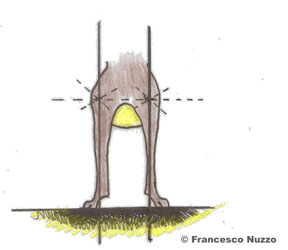 |
ELBOW |
FOREARM |
|
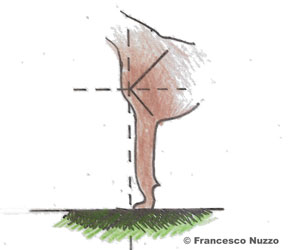 |
| This channel, as well as being a sign of distinction, denotes the power of the forearm, acting, the pisiform, as a lever arm. In general we say that a long-forearm generates a big step and the longitudinal diameter (referred to verticality or lenght) must be accompanied by an adequatly strong development of the bones (ie transverse diameter referred, therefore, to the horizontal or width) as well as a proper muscle development. The upright (a plumb) of the forearm is assessed frontally, dropping an imaginary straight line (a plumb line) from the scapulo-humeral angle perpendicularly to the ground, dividing this specific anatomical region into two equal parts. It is from this assessment, made from the front, that sometimes, is found in our breed the evagination (outward deviation) of the radius and ulna, and this valgus fault is called "Lyre forearm, " this because the forearm tends to be vaguely shaped as the musical instrument (Lyre). The assessment of the forearm, carried out from the side, is made, instead, by drawing an imaginary line , always vertical and perpendicular to the ground, which will go from the center of the elbow joint, always dividing into two equal portion the forearm and the carpal and will go across the metacarpal at the middle of its length, touching the ground at the rear of the foot. So the evaluation of the morphological and functional parameters of the forearm are longitudinal and transverse diameters, respectively the length and width of the spokes, and direction, ie vertical.So the evaluation of morphological and functional forearm longitudinal and transverse diameters are respectively the length and width of the ray, and direction, which is vertical. CARPO Of a nearly flattened shape, its anatomical basis is formed by the seven carpal bones. Above the wrist articulates with the distal ends of the forearm bones and below with the metacarpal bones. The wrist should be in line with the forearm and must be very mobile in order to ensure the flexion-extension and lateral movements, even if the latter are rather modest. The evaluation of the wrist is fulfilled in its two projection, front and side. In examining from the side, that is made watching the subject in profile, we may find a wrist projected forward beyond the line formed by the forearm, in this case we will talk about "chair leg"; viceversa if it is arched toward the back we talk of a "hollow wrist". In the frontal evaluation , the wrist may present straight, or correct, but may be faulty: deflected towards the inside "turned in ", or to the outside "turned out". The first will lead to the outside deviation , of the metacarpus and foot, thus generating the so called chair leg (varo) . Similarly, the deviation of the wrist to the outside, (valgus), give rise to the diversion to the inside of the pastern and foot, the so called bow-legged. PASTERNS Quadrangular pyramid-shaped, its anatomical basis consists of the five metacarpal bones and the adjoining of the region. Jointed above with the carpus, below it meets with the phalanges, forming the metacarpophalangeal joint, and is the third and last angle towards the ground of the foreleg.The standard requires for the Chihuahua a pasterns slightly sloping, strong and elastic. The reason for these features is easily understood if we think about the functions that this region has to play: to absorb and amortize mechanical stress and trauma every time the foot comes into contact with the ground, the pastern has a so-called function of physiological "shock absortion". We can say that the pastern is in a upright correct position when, watching from the front, a vertical line, which starts from the scapulo-humeral angle coming down, will split it into two perfectly equal parts. We recall the left-handedness and bow-legged as two faults that affect this region and whose genesis we have said above. FOOT In a distal position to the metacarpal, the region of the foot has as anatomical basis twelve phalanges, three for each finger, and includes the central ball of the foot, the digital pads, one for each finger, and the nails.The foot, as well as being important anatomical region for the dog because it is the contact to the ground, is also an important landmark for the evaluation of the front upright seen in profile. Returning to the imaginary vertical line from the scapular humeral joint, to the ground, if the the foot remains behind this, it is said that the dog is under, while in the opposite case it is said its beyond. |
||
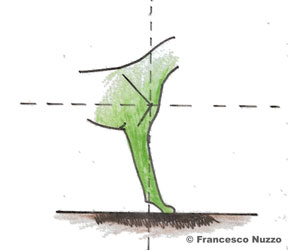 |
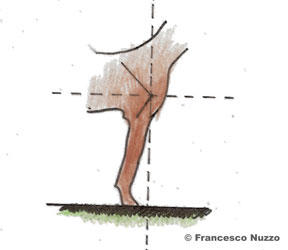 |
The Chihuahua the foot must be small and oval in shape shortened, and this is particularly well specified in the Standard that requires "no cat feet nor hare's feet." We clarify that, in dog-science, that is called "cat-foot" the round shaped foot while we call "hare foot" a elongated and oval shaped foot. Nails should be well arched and paws well developed. In the evaluation of a subject is desirable to pay great attention to these details of the region of the foot, because it is with the ball of the foot, with the paws and nail that our Chihuahua makes contact with the ground. |
diriogaleria@chihuahua.it | musicvelvet@chihuahua.it
Words and images ©2011 Di Rio Galeria & Music Velvet Kennels - All rights reserved | Web site by TwentyfourCatsandDogs ©

